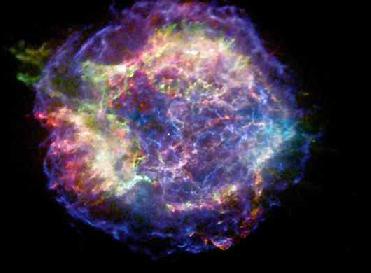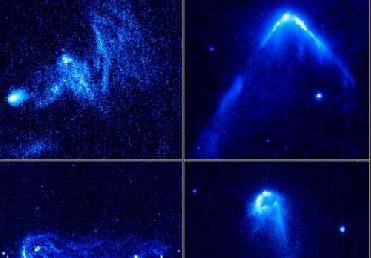
Chandra X-ray Images of Cassiopeia A taken in December 2007. NASA photo
WASHINGTON (BNS): NASA's Chandra X-ray Observatory has helped astronomers pick up two new efforts from a famous supernova remnant from the static to the dynamic. The data shows changes in time never seen before in this type of object.
According to NASA, it was nearly ten years ago, Chandra�s �First Light� image of Cassiopeia A (Cas A) revealed previously unseen structures and detail. Now, after eight years of observation, scientists have been able to construct a movie that tracks the remnant's expansion and changes over time, NASA said.
Daniel Patnaude of the Smithsonian Astrophysical Observatory in Cambridge, Massachusetts said that with Chandra, they had watched Cas A over a relatively small amount of its life, but so far the show has been amazing. �And, we can use this to learn more about the aftermath of the star's explosion,� Patnaude said.
The results of the fascinating visualisation featuring Cas A was presented, along with the Patnaude team's results, at a press conference at the American Astronomical Society meeting in Long Beach, California. NASA said that based on data from Chandra, NASA's Spitzer Space Telescope, and ground-based optical telescopes, Tracey DeLaney and her colleagues have created the first three-dimensional fly-through of a supernova remnant.
DeLaney of the Massachusetts Institute of Technology said that they had always wanted to know how the pieces one sees in two dimensions fit together with each other in real life. �Now we can see for ourselves with this �hologram� of supernova debris,� DeLaney said.
Harvard�s Alyssa Goodman who heads the Astronomical Medicine project said that right now, they were focusing on improving three-dimensional visualisation in both astronomy and medicine. �This project with Cas A is exactly what we have hoped would come out of it,� Goodman said.
While these are stunning visuals, both the data movie from Patnaude and the 3-D model from DeLaney are, more importantly, rich resources for science. The two teams are trying to get a much more complete understanding of how this famous supernova explosion and its remnant work, NASA said.
The space agency said that Patnaude and his team have measured the expansion velocity of features in Cas A from motions in the movie, and find it is slower than expected based on current theoretical models. However, Patnaude thinks the explanation for this mysterious loss of energy is cosmic ray acceleration.
According to scientists, Cassiopeia A is the remains of a star thought to have exploded about 330 years ago, and is one of the youngest remnants in the Milky Way galaxy. The study of Cas A and remnants like it help astronomers better understand how the explosions that generate them seed interstellar gas with heavy elements, heat it with the energy of their radiation, and trigger shock waves from which new stars form.
 Previous Article
Previous Article













The Indian Air Force, in its flight trials evaluation report submitted before the Defence Ministry l..
view articleAn insight into the Medium Multi-Role Combat Aircraft competition...
view articleSky enthusiasts can now spot the International Space Station (ISS) commanded by Indian-American astr..
view article